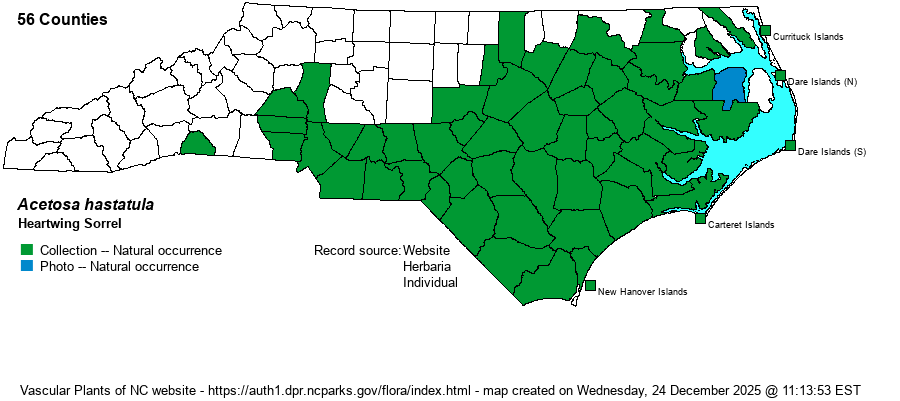| Author | (Baldwin) Á.Löve | |
| Distribution | This species was moved into a different genus by Weakely (2023) -- now is Acetosa hastatula. Throughout the Coastal Plain, including the Outer Banks, west to the Triangle area and southern Piedmont; ranges inland to Granville, Iredell, Catawba, and Polk counties.
NY southward in the Coastal Plain to central FL, TX, and NM. Northward far inland to southern IN and KS. Scarce in the Piedmont and absent in Mountains. However, Weakley (2024) states that "The eastern part of the distribution seems to be strictly or mostly in altered habitats, suggesting the possibility that the eastern extent (east of the Mississippi River) of the distribution is adventive." As a result, his 2024 map shows all Southeastern states as "maybe exotic". The website editors retain the species as a native, at least for the time being. | |
| Abundance | Common to abundant in most of the Coastal Plain and Sandhills; fairly common to common in the southern Piedmont, but scarce in the northeastern Piedmont. Not common in the northeastern Coastal Plain. | |
| Habitat | Dry, sandy, acid soils of fallow fields, fallow croplands, roadsides, neglected yards, other disturbed areas. Behaves as a non-native species, but it seems to be native to the eastern U.S., partly owing to its tight distribution; non-native species tend to have more scattered populations showing on range maps. In early spring, fields may be colored reddish by it, often mixed with blue flowers of Canada Toadflax (Linaria canadensis) to produce a pleasing visual effect. | |
| Phenology | Flowering and fruiting March-June. | |
| Identification | Heartwing Sorrel is typically 1-2 feet tall, with several basal and lower stem leaves that have 2 basal, sharp lobes (hastate). The stem has stiffly ascending branches that produce densely-flowered, reddish-tinged inflorescences. Sepals grow prominent heart-shaped wings. The non-native and equally abundant Sheep Sorrel (A. acetosella) is very similar, but its sepals do not form wings and it is a much shorter plant (up to 1 foot tall versus 1-2 feet tall in Heartwing Sorrel). | |
| Taxonomic Comments | Moved into the genus Acetosa, in Weakley (2023), as was the former Rumex acetosella; this species was formerly named as Rumex hastatulus and still is by most authorities.
| |
| Other Common Name(s) | Hastate-leaved Dock, Heartwing Dock | |
| State Rank | S5 | |
| Global Rank | G5 | |
| State Status | | |
| US Status | | |
| USACE-agcp | | |
| USACE-emp | | |

